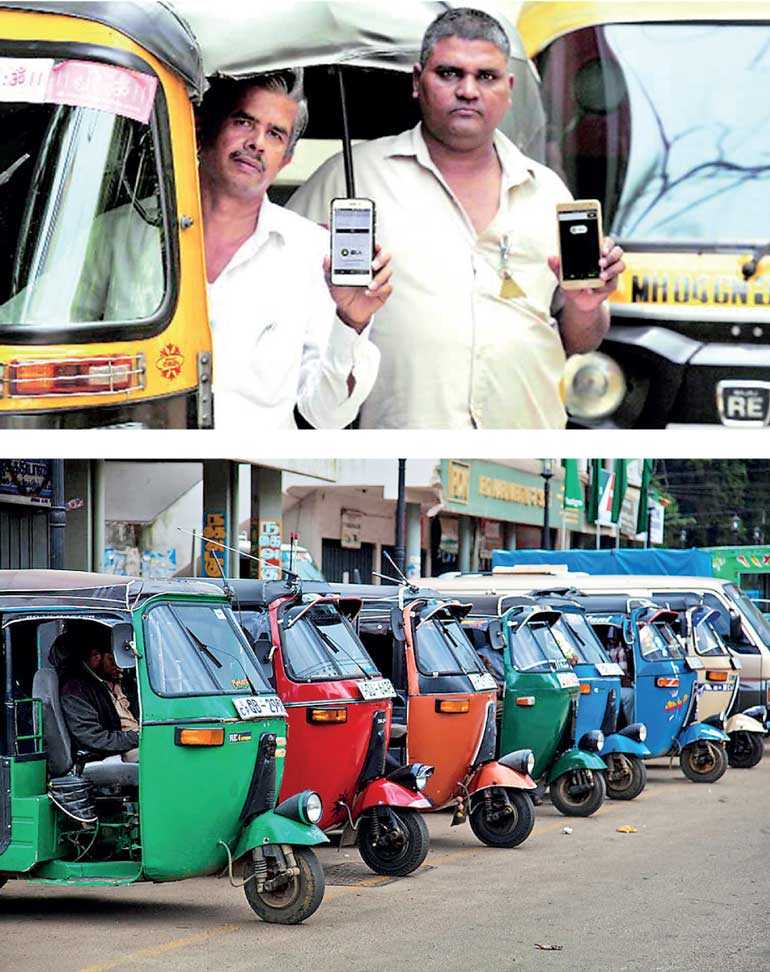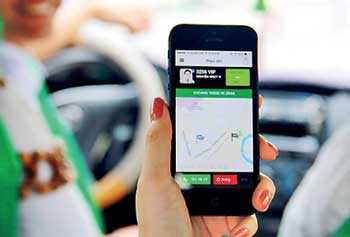Thursday Jan 15, 2026
Thursday Jan 15, 2026
Tuesday, 13 November 2018 00:45 - - {{hitsCtrl.values.hits}}

The advent of taxi-hailing apps changed the way Sri Lankans access three-wheelers and cabs. The average Sri Lankan mainly relies on three-wheelers to get from one point to the other, and long before the app-based taxi-hailing culture took root, three-wheeler drivers had the final say in the rate for each ride. Those days the sight of a would-be passenger haggling with a driver was a common sight. Three-wheel meters, which made an appearance sometime after, somewhat evened the playing field for passengers. However, with the introduction of taxi-hailing apps, the entire game changed. Recently, a group of three-wheel drivers organised a protest against such apps, claiming that the playing field had once again acquired a slope to the disadvantage of unaffiliated drivers. Let us take a look at what is really going on.
Passengers
Recently, ITN aired a program in which they talked to people from both sides of the spectrum. In the program, passengers reveal that they still use a combination of choosing a metered three-wheeler from a designated stand, hailing one off the road, and using a taxi-hailing app to book a three-wheeler.
Passengers first and foremost seek a fair price, along with safety. Out of the three-wheel services available today, the random vehicles without a fixed meter charges passengers the highest rate. Even though this type of service is rarely seen in Colombo or the major cities, once you venture further in, most three-wheeler drivers still stick to the old method of dictating a price that they deem fit at any given moment. Three-wheelers with working meters attached offer a fairer and a more manageable rate in comparison. The downside of this is that since most meters are not properly regulated, drivers can easily manipulate the meter, and charge unsuspecting or hapless passengers exuberant rates. However, taxi-hailing app-based vehicles offer the lowest rate.
Safety-conscious passengers invariably choose to rely on an app-based taxi-hiring systems, as most platforms allow passengers the facility to track the driver and the route. As one of the passengers related, in case they leave behind personal belongings behind in the vehicle by accident, the tracking system acts as a lifesaver. Moreover, reliable and reputed app-based taxi-hailing companies hold their drivers accountable, which allows passengers to travel without losing being overly anxious about their safety. In good old Sri Lanka, reliability is a bonus. Generally and in the writer’s own experience, app-based taxi-hailing services are reliable as they answer to a central entity.
While some passengers admit to using app-based taxi-hailing services simply as they offer the lowest rates in the market, an emerging number of passengers claim that they would use such services simply to feel safer during their travels. In a nutshell, passengers would always choose the option that provides them a fair rate, along with the guarantee of safety and perhaps reliability.
Drivers
 In the case of drivers, many of those who prefer to operate independently do so as it allows them more freedom to manage other aspects of lives along with work. For example, a working father would prefer to have a timeframe free to take kids to and from school. As a driver who switched to working for an app-based company after working independently with a meter attached to his three-wheeler attested, app-based services bring in more hires. One driver argued that while he can charge more from passengers if he operates independently, working in partnership with a company allows him to find an increased volume of hires.
In the case of drivers, many of those who prefer to operate independently do so as it allows them more freedom to manage other aspects of lives along with work. For example, a working father would prefer to have a timeframe free to take kids to and from school. As a driver who switched to working for an app-based company after working independently with a meter attached to his three-wheeler attested, app-based services bring in more hires. One driver argued that while he can charge more from passengers if he operates independently, working in partnership with a company allows him to find an increased volume of hires.
For Example, one of Sri Lanka’s taxi-hailing service PickMe, operates at the lowest per KM rate to the passengers, whilst complimenting the drivers with high incentive schemes varying as per fleet and driver preference of full-time or part-time.
As a recent report indicates, mobile penetration in Sri Lanka has risen from 96% in 2012 to 126% in 2017. As more and more Sri Lankans get used to relying on various apps (a growing trend in Sri Lanka), taxi-hailing apps too will become even more relevant.
Conclusions
Sri Lanka’s app-based taxi-hailing market is a competitive one.
The number of companies that offer this service has increased as of late. As long as the competition is healthy and no one tries to offer ridiculously lower rates to scare off competition and then build a monopoly, the new system should work in favour of both passengers and drivers.